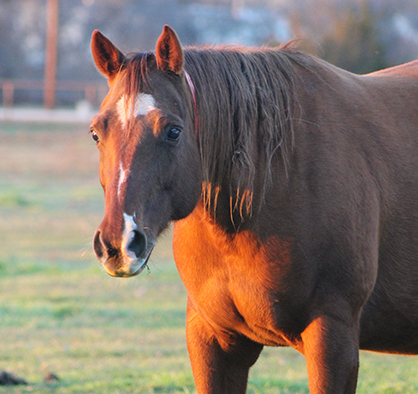New Research Shows Even Healthy Older Horses Have Increased Insulin Responses
New research conducted in collaboration with BUCKEYE™ Nutrition shows that healthy older horses have increased insulin responses to a starch-rich or starch- and sugar-rich meal, when compared to younger horses. This suggests that, whether diagnosed with insulin dysregulation or not, older horses need an appropriate diet and management plan to help minimize the risks associated with insulin dysregulation, such as laminitis.
Insulin is a hormone produced by the pancreas. The release of insulin signals cells, especially in the muscle and liver, to take up glucose from the blood. A high level of insulin in the blood (hyperinsulinemia) may or may not be accompanied by insulin resistance (failure of cells to respond appropriately to insulin). This is why a new term, “insulin dysregulation,” is now used to refer collectively to excessive insulin responses to sugars, and/or fasting hyperinsulinemia and/or insulin resistance.
Two new studies, conducted by WALTHAM®, who provides the science behind the BUCKEYE™ Nutrition brand, in collaboration with Michigan State University, aimed to find out more about the relationship between insulin dysregulation, dietary adaptation, and aging to help guide more appropriate feeding regimens for senior horses. Both studies investigated tissue insulin resistance and the insulin response in healthy adults compared to healthy senior horses adapted to diets with varying levels and sources of structural and non-structural carbohydrates (starch, sugar, and fiber).
Results from both studies show that insulin responses tend to increase with age in healthy horses regardless of the diet they had been fed prior to evaluation. The insulin response, for example, was highest in the senior horses fed a starch-rich meal even after an adaptation period to that diet.
Dr. Nettie Liburt, Senior Equine Nutrition Manager at BUCKEYE™ Nutrition said, “These studies confirm that even healthy older horses can have an increased insulin response compared to younger animals. Energy sources in diets formulated for seniors therefore should be carefully selected and balanced to help manage insulin secretion after a meal. This is even more critical in horses with PPID, Equine Metabolic Syndrome or who are obese. Starches and sugars should be carefully controlled in the senior horse’s diet, with suitable forage, whenever possible, being the basis of a healthy ration.”
These studies are two of a number of exciting BUCKEYE™ Nutrition research collaborations aimed at making the U.S., Canada, and the world a better place for all horses, including senior horses.
References
Rapson J.L. , Schott II H.C. , Nielsen B.D. , McCutcheon L.J. , Harris P.A. & Geor J. Effects of age and diet on glucose and insulin dynamics in the horse. Equine Veterinary Journal https://doi.org/10.1111/evj.12812
Jacob, S. I., Geor, R. J., Weber, P. S. D., Harris, P. A. and McCue, M. E. (2018), Effect of age and dietary carbohydrate profiles on glucose and insulin dynamics in horses. Equine Vet J. 50: 249 – 254. https://doi.org/10.1111/evj.12745
WALTHAM is a leading scientific authority on the nutrition and health of companion animals. The WALTHAM Equine Studies Group, which is headed by Professor Pat Harris MA PhD VetMB DipECVCN MRCVS, is dedicated to advancing the science of horse nutrition and provides the scientific support for MARS Horsecare globally including the SPILLERS®, WINERGY® and BUCKEYE™ Nutrition brands. By collaborating with key research institutes and universities around the world its work remains at the forefront of equine nutritional science.
®WALTHAM is a registered trademark.











